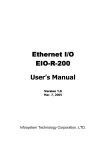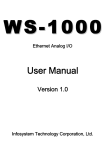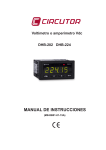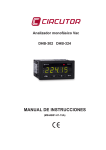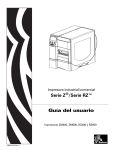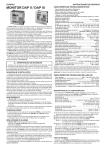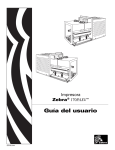Download Eusso 5-Port Product specifications
Transcript
FCC Warning This equipment has been tested and found to comply with the limits for a Class B digital device, pursuant to Part 15 of the FCC Rules. These limitations are designed to provide reasonable protection against harmful interference in a residential installation. This equipment generates, uses and can radiate radio frequency energy and, if no installed and used in accordance with the instructions, may cause harmful interference to radio communications. However, there is no guarantee that interference will not occur in a particular installation. Changes or modifications to the equipment that are not approved by the party responsible for compliance could affect the user’s authority to operate the equipment. CE Declaration of conformity This equipment complies with the requirements relating to electromagnetic compatibility, EN 55022 class B for ITE, the essential protection requirements of Council Directive 89/336/EEC on the approximation of the laws of the Member States relating to electromagnetic compatibility. Trademarks: All trade names and trademarks are the properties of their respective companies. Copyright © 2003, All Rights Reserved. Document Version: 2.0 Table of Contents 1. Unpacking Information 2. Introduction To Ethernet over VDSL Converter 2.1 2.2 2.3 2.3.1 2.3.1.1 2.3.1.2 2.3.1.3 2.3.1.4 2.3.1.5 2.3.1.6 2.3.1.7 2.3.2 2.4 2.4.1 3. Installing And Using Ethernet over VDSL Converter 3.1 3.1.1 3.1.2 3.1.2.1 4. General Description Key Features The Front Panel LEDs definition STATUS LED Power LED 100M LED (Ethernet) LINK/ACT LED (Ethernet) FDX/COL LED (Ethernet) LINK LED (VDSL) ACT LED (VDSL) MODE DIP switch The Rear Panel Power Connecting Installing The Ethernet over VDSL Converter Connect to Internet Access Concentrator Installing Network Cables Station Connections with Telephone Wires Product Specifications 1 1. Unpacking Information Thank you for purchasing the Ethernet over VDSL converter. Before you start, please check all the contents of this package. The product package should include the following: 1. 2. 3. 4. One Ethernet over VDSL Converter One power cord One telephone line User’s Manual 2 2. Introduction To Ethernet over VDSL Converter 2.1 General Description The converter is a switching architecture with one RJ-45 10/100Mbps Ethernet port and one maximum 17Mbps symmetric/asymmetric RJ-11 Ethernet over VDSL port (with 2 connectors). It is ideal for signal conversion by transmitting the Ethernet data from the standard twisted pair cable to the telephone cable and extending the distance. The Ethernet over VDSL combines the well proven Ethernet and VDSL technology to transmit the Ethernet format data by using VDSL signaling over the most widespread telephone wires and has no impact to current voice service. Therefore, it is very good for Internet building phoneline network because every room or house could use the existing phoneline to transmit data to the Internet and the whole building could share the Internet line to the wide area network with minimum cost. With much enough bandwidth, the 17Mbps symmetric capability enables many multi-media services on local Internet come true, like VOD (Video On Demand), Internet caching server, distance education, … and so on. In one community or hotel, we just need to install one local server then the multi-media services will be localized that is 3 people do not need to access the services through Internet but using local area network with better bandwidth and efficiency. Meanwhile, this kind of infrastructure will minimize the burden on the Internet. The converter is plug-n-play without any software to configure and also fully compliant with all kinds of network protocols. Moreover, the rich diagnostic LEDs on the front-panel provide the operating status of individual port and the whole system. The cable specifications of the connection are listed as following: 10BASE-T, Category 3, 4 or 5 UTP/STP 100BASE-TX, Category 5 UTP/STP Ethernet over VDSL, Twisted-pair telephone wires The drawing listed below is typical application for the Ethernet over VDSL converter. Master Phone line Slave 4 Telephone 2.2 Key Features The converter provides the following key features: • Complies with IEEE802.3 10BASE-T standard • Complies with IEEE802.3u 100BASE-TX standard • Supports Ethernet over VDSL • 5 * selective transmission modes • 2 * RJ-11 connectors for maximum 17Mbps symmetric/asymmetric Ethernet over VDSL port, one for LAN connection and one for voice connection. • 1 * 10/100Mbps Ethernet port • 8Kbytes Ethernet transmit and 16Kbyte Ethernet receive buffers • Supports extensive LED indicators for network diagnostics • External Linear Power • FCC Class B, CE 5 2.3 The Front Panel The front panel of the converter is shown below. Master Slave 2.3.1 LEDs definition The rich diagnostic LEDs on the front panel can provide the operating status of individual port and whole system. 2.3.1.1 Status LED (Master) The LED blinks periodically to show the ADSL Router is working normally. If the LED stays green/dark that means the system is fail, you need to contact your agent or try to reboot the system. 2.3.1.2 Power LED This indicator lights green when the converter is receiving power; otherwise, it is off. 6 2.3.1.3 100M LED (Ethernet) The RJ-45 port has a 100M LED. Steady green indicates that the port is operating at 100Mbps. If the LED is off, the link speed is 10Mbps. 2.3.1.4 LINK/ACT LED (Ethernet) The RJ-45 port has a LNK/ACT LED. Steady green (link state) indicates that the port has good linkage to its associated device. Flashing green indicates that the port is receiving or transmitting data from/to its associated partner. If the port is connected but the LNK/ACT LED is dark, check the following items: 1. The converter and the connected device’s power are on or not 2. The port’s cable is firmly seated in its connectors in the switch and in the associated device. 3. The connecting cable is good and with correct type. 4. The connecting device, including any network adapter is functional. From the LED of LNK/ACT, we could judge the connection as following: 7 LINK/ACT LED (Ethernet) Status Off No Connection Green 10/100Mbps 2.3.1.5 FDX/COL LED (Ethernet) A collision occurs when two stations within a collision domain attempt to transmit data at the same time. Intermittent flashing amber of the collision LED is normal; the contending adapters resolve each collision by means of a wait-then-retransmit algorithm. Frequency of collisions is an indicator of heavy traffic on the network. If the FDX/COL lights amber which means the port is under full-duplex operation or dark for half-duplex mode. The following table is a summary of Port LEDs. LED (Ethernet) 100M Operation 100Mbps (Green), 10Mbps (Off) LINK/ACT Link is present (Green), Activity (Blinking Green) Full-Duplex (Amber), Half-Duplex (Off), COL (Blinking Amber) FDX/COL 8 2.3.1.6 LINK LED (VDSL) If both ends of the VDSL devices are connected then the LED will blink for a while (in 10 seconds), this is the stage of speed auto-negotiation. After the negotiation process, the Link LED will stay green. If the LED blinks always, that means the link process is fail. 2.3.1.7 ACT LED (VDSL) If there is any traffic transverses the port then the LED will light green. Otherwise, off means no traffic on the network. 2.3.2 MODE DIP Switch (Master) The converter provides 5 selective transmission modes that defined by predetermined profiles. By switching the transmission modes, you can obtain a best transmission mode to suit with phone line quality or distance of connectivity. The following is the summary table of transmission modes, bandwidth and distance extensibility tested for AWG 26 (0.4mm) twisted-pair without noise and cross talk. Profile Name Profile Type Downstream Upstream Maximum Distance Rate (Mbps) Rate (Mbps) between the CO Port and the CPE ANSI ETSI VE-5 VE-10 VE-15 Public Public Private Private Private 15.17 11.38 5.69 11.38 15.17 4.27 4.27 5.69 11.38 17.06 9 2900 ft 3200 ft 3600 ft 3200 ft 2900 ft Transmission mode ANSI ETSI VE-5 VE-10 (Default) VE-15 2.4 DIP switch ON 1 2 3 4 1 2 3 4 1 2 3 4 1 2 3 4 1 2 3 4 ON ON ON ON The Rear Panel The rear panel of the converter is shown below 2.4.1 Power Connecting Plug the circle end of the power adapter firmly into the rear panel of the switch, and the other end into an electric service outlet then the system is ready. 10 3. Installing And Using Ethernet over VDSL Converter 3.1 Installing The Ethernet over VDSL Converter The converter does not require any software configuration. Users can immediately use any feature of this product simply by attaching the cables and plug power on. There is some key limitation on the Ethernet over VDSL networking, please check the following items: The device is used for point-to-point connection only and allows data and voice work on the same telephone lines. The two RJ-11 connectors, one for voice device connection (like telephone) and the other one for network line connection Therefore, this device is an ideal client access unit for the applications of apartment, hotel, campus and hospitality. Integration with the Internet access Concentrator, the total infrastructure could be a perfect solution for multi-media local Internet. This structure could support many multi-media applications, like VOD (Video on Demand), Distant education, Internet caching server, … and so on. Therefore, most of the traffic will be limited on the local phoneline network instead of flooding to the Internet. Another application for the converter is used for LAN to LAN extension through the normal telephone line. 11 3.1.1 Connect to Internet Access Concentrator In order to build up a local Internet in apartment, hotel, campus and hospitality environment, the Internet Access Concentrators need to be placed in the wiring center (MDF room) and connect to the telephone line system. On the other hand, you need to install a converter on the individual client side and connect to the Concentrator through the telephone lines. When deciding where to put the converter then you must ensure: It is accessible and cables can be connected easily Cabling is away from sources of electrical noise such as radios, transmitters and power lines and fluorescent lighting fixtures. Water or moisture can not enter the unit Air flow around the unit and through the vents in the side of the case is not restricted (company recommend that you provide a minimum of 25mm clearance) To prolong the operational life of your units: Do not place objects on top of any unit or stack Do not obstruct any vents at the sides of the case 3.1.2 Installing Network Cables After placing the converter on the desktop, then we need to know how to connect the device to network. 12 3.1.2.1 Station Connections with Telephone Wires Connect the network adapters in stations to the converter’s RJ-45 port through category 3, 4 or 5 UTP/STP cables. There are two RJ-11 phone jacks; one for telephone set connection and the other one is used for phoneline network connection. If you have telephone wall jacks at home then all you need to do is connecting the RJ-11 network port to the wall jack through telephone wires. 13 4. Product Specifications Standard IEEE802.3 10BASE-T IEEE802.3u 100BASE-TX Ethernet over VDSL Interface 1 * 10/100Mbps Ethernet port 2 * RJ-11 connectors for Ethernet over VDSL and telephone set 1 * transmission modes DIP switch Cable Connections RJ-45: Category 3,4,5 UTP/STP VDSL: Twisted-pair telephone wires Network Data Rate Ethernet: 10/100Mbps VDSL: Maximum 17Mbps LED indications System Power x1 Status x 1 (Master) Ethernet Port 100M x1 LINK/ACTx1 FDX/COLx1 VDSL port LINKx1 ACTx1 System Memory 8Kbyte Ethernet transmit and 16Kbyte Ethernet receive buffers Emission FCC Class B, CE Operating Temperature 00 ~ 500C Operating Humidity 10% - 90% Power Supply External Linear Power UVE7311-MS 14















